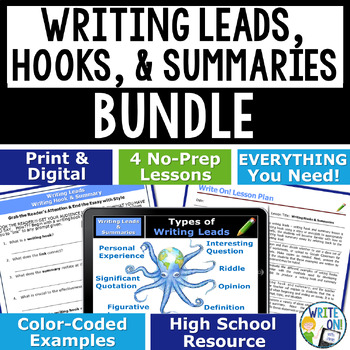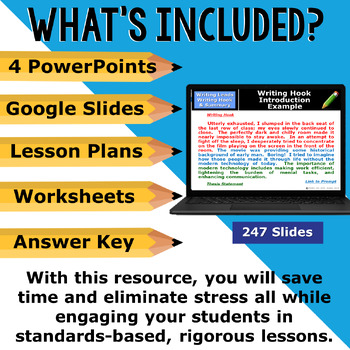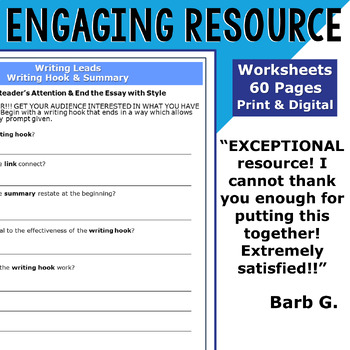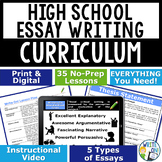Writing Leads, Writing Hooks, & Endings for Essay Introductions & Conclusions
- Zip
- Google Apps™
- Easel Assessment

Products in this Bundle (4)
Bonus
Also included in
- Teaching how to write argumentative, compare and contrast, expository, narrative, and persuasive essays has never been easier! These 35 lessons include everything you need to implement rigorous, interactive writing instruction in your classroom. Every lesson has numerous examples and anchor essaysPrice $63.91Original Price $177.71Save $113.80
Description
Teaching how to write writing leads and conclusions has never been easier! Each lesson in this in-depth introductions and conclusions writing resource will help guide students through the entire process of writing a hook that will grab the reader and a summary that will wrap up the essay. Additionally, writing lead and conclusion anchor paragraphs provide students the opportunity to see how the writing process works. From the struggling writer to the advanced writer, this resource offers something for everyone.
These no prep lessons can be used in class or assigned for distance learning as independent student work with Google™ Links is provided. The step-by-step guided note-taking can be presented as whole class instruction or assigned for students to complete at home.
These resources explain the entire process of writing thorough and concise writing leads and ending paragraphs and using them in essay writing. The PowerPoints and worksheets allow students to practice and develop their writing skills. The detailed lesson plans make implementing the lesson easy for teachers.
The lessons have numerous examples of writing lead introductions and conclusions. These examples are included on the student worksheets, so students can make corrections and identify writing elements on their worksheets.
Each resource listed below is included in Google Drive™ and print format.
*****************************************************************************************
Each Lesson in the Writing Leads, Writing Hooks, Summaries - Introductions and Conclusions Unit includes:
Writing Leads and Conclusions Lesson Plan with:
- Common Core State Standards Indicated on lesson plan
- Instructional Focus
- Instructional Procedures
- Objectives/Goals
- Direct Instruction
- Guided Practice
- Enrichment
- Differentiation
- I Can Statement
- Essential Question
- ESE Strategies
- ELL Strategies
Writing Leads and Conclusions Worksheets with:
- Explanations and examples of the different methods for the different types of writing leads, writing hooks, and introductions
- Explanations and examples of the different methods for the different types of endings, summaries, and conclusions
- Opportunities for students to practice guided note-taking
- "Now It's Your Turn" section for students to practice skills learned
Writing Leads and Conclusions PowerPoint Presentation with:
- Introduction slides with explanations of writing hooks - writing leads
- Explanations and examples of writing summaries - writing conclusions
- Guided note-taking sections
- Examples of writing hooks - writing leads used in essays
- Examples of writing endings - writing conclusions used in essays
Google Slides
*****************************************************************************************
Connect with me for the latest Write On! with Jamie news:
. . . and visit my WRITE ON! with Jamie website for a free TEXT EVIDENCE WRITING LESSON!
Write On!
Jamie
© Google Inc.™ All rights reserved. Google™ and the Google Logo are registered trademarks of Google Inc.™ Write On! with Jamie® is an independent company and is not affiliated with or endorsed by Google Inc.™
Terms of Use
Copyright © Write On! with Jamie. All rights reserved by author. All components of this product are to be used by the original downloader only. Copying for more than one teacher, classroom, department, school, or school system is prohibited unless additional licenses are purchased. This product may not be distributed or displayed digitally for public view. Failure to comply is a copyright infringement and a violation of the Digital Millennium Copyright Act (DMCA). Clipart and elements found in this product are copyrighted and cannot be extracted and used outside of this file without permission or license. Intended for classroom and personal use ONLY.






